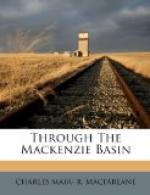For a long distance the upper prairie level exposes good soil, always clay loam, and there can be little doubt that there is much fertile land in this district. That night we slept, or tried to sleep, in the boat, and made a very early start on a raw, cloudy morning, the tracking being mainly in the water. We now passed great cliffs of sandstone, some almost shrouded in the woods, and came upon many peculiar circular stones, as large as, and much resembling, mill-stones. Towards evening we passed Pointe la Biche, and met Mr. Connor, a trader, with two loaded York boats, going north, and whom we silently blessed, for he brought additional mail for ourselves. What can equal the delight in the wilderness of hearing from home! It was impossible to make Grand Rapids, and we camped where we were, the night cold and raw, but enlivened by the reading and re-reading of letters and newspapers.
Next morning, crossing the right bank of the river, and leaving the boat, we walked to the foot of Grand Rapids. Our path, if it could be called such, lay over a toilsome jumble of huge, sharp-edged rocks, overhung by a beetling cliff of reddish-yellow sandstone, much of which seemed on the point of falling. This whole bank, like so much of this part of the river, is planted, almost at regular intervals, with the great circular rocks already referred to. These globular or circular masses are a curious feature of this region. They have been shaped, no doubt, by the action of eddying water, yet are so numerous, and so much alike, as to bespeak some abnormally uniform conditions in the past.
The Grand Rapids—Kitchi Powestik—the most formidable on the river, are divided by a narrow, wooded island, over a quarter of a mile in length, upon which the Hudson’s Bay Company have a wooden tramway, the cars being pushed along by hand. Towards the foot of the island is a smaller one near the left shore, and here is the larger cascade, a very violent rapid, with a fall from the crest to the foot of the island of thirty feet, more or less. The narrower passage is to the right of the island, and is called the “Free Traders’ Channel.” The river, in full freshet, was very muddy-looking, detracting much from the beauty of the rapids.
The Hudson’s Bay Company have storehouses at each end of the tramway, but for their own use only. Free traders have to portage their supplies over a very rough path beneath the cliffs. Both banks of the river are of sandstone, capped on the left by a wall of cream-coloured rock, seventy or eighty feet in height, at a guess. A creek comes in from the west which has cloven the sandstone bank almost to the water’s edge; and running along the top of these sandstone formations are, everywhere, thick layers of coal, which is also found, in a great bed, on the opposite shore, and about three miles back from the river. The coal had been used by a trapper there, and is a good burner and heater, leaving little




